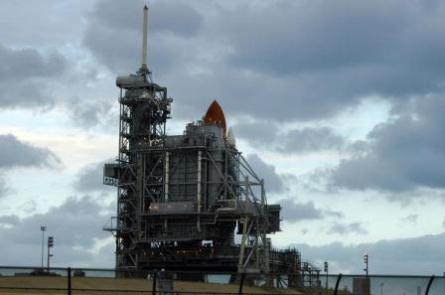|
|
|---|
| Above: Discovery sits at pad 39B early on the morning of 9 December before Rotating Service Structure roll back |
As it takes around 3h to fuel the ET and because of the many elements required to occur before, during and after that operation to ready a Shuttle to launch, if fuelling does not begin at 12:30h the Kennedy Space Center (KSC) team will be unable to have the vehicle prepared for lift off by its launch window that opens at 20:47h.
Weather conditions over KSC on Friday led NASA to opt for Saturday 9 December just an hour after scrubbing that launch of Discovery on Thursday 7 December. However Saturday was predicted to have a 70% chance of weather prohibiting launch.
If NASA cannot launch Discovery today, due to the fuelling operation delay or the weather, then the agency will examine its cryogenic propellant resources to determine if Sunday 10 December is the next day for an attempt.
Low cloud cover, between 4,000ft (1,220m) and 8,000ft, that was 500ft thick ended Discovery's launch hopes on Thursday after a countdown replete with alternating rulings on the weather. With an hour to go before that launch low level cloud cover over KSC had broken and NASA was then expecting Discovery to lift off at 21:35h 48s local time (02:35h GMT).
At T-5min a decision was taken to hold the countdown and due to continued concerns over cloud cover the launch was halted at 21:36h. The launch window opened for 10min at 21:35h 48s. The US space agency fears low cloud cover as NASA needs to be able to observe an ascending Shuttle up to 6,000ft altitude and the Orbiter crew need to be able to see the KSC runway if they have to abort the launch at a low level and can return to the space centre.
Discovery's mission STS-116 is the 117th Shuttle mission, the 20th US construction mission to the International Space Station (ISS) and the Orbiter's 33rd flight. During the mission's three extra-vehicular activities astronauts will install the P5 port truss segment, retract the P6 port solar array's wing and radiators and move power cables to enable the ISS to draw power from the arrays installed in September by Space Shuttle Atlantis' crew on STS-115.
The STS-116 crew are NASA astronauts William Oefelein, pilot; Mark Polansky, commander; Joan Higginbotham, Robert Curbeam, British born Nicholas Patrick, Sunita Williams and the European Space Agency's Christer Fuglesang, all mission specialists. Curbeam, Fuglesang and Williams will conduct the space walks. Williams will not return with Discovery and instead join the ISS's current Expedition 14 and serve as a flight engineer aboard the station. Thomas Reiter, who arrived at the ISS onboard Discovery on mission STS-121 in July will return to Earth with the crew of STS-116 this month.
The launch of Discovery/STS-116 will potentially be the last from pad 39B as it is to be used for the development of NASA’s proposed Ares I crew launch vehicle. Shuttles will in future be launched from pad 39A. However because of NASA’s ongoing policy of launching a rescue shuttle if an Orbiter discovered it was damaged after its ascent pad 39B is required for a second Shuttle to be readied for flight for the Hubble Space Telescope servicing mission before pad 39A will be available.
Source: FlightGlobal.com

















